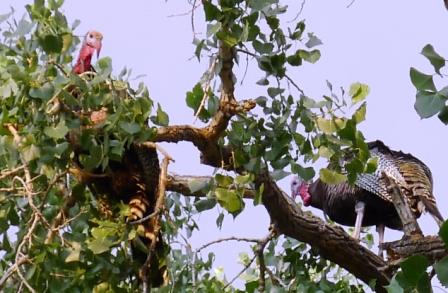A shot of wild turkey
Runaway pets or mongrel pests, the quirky birds are Corrales

When you’re talking turkeys here, Village politics probably comes first to mind. But there are actually gobblers roaming the streets and ditches that are widely loved—and not for target practice.
Turkeys, as schoolchildren know, are native to the Americas and inhabited the Rio Grande Valley for millennia. Native Americans kept turkeys among their few domesticated animals. But those colorful fowl you see picking their way through the berry fields on the south end of the Village look suspiciously more Butterball than Meleagris gallopavo, their wild cousins.
That’s because Corrales’ turkeys are actually a cross between one or more wild species and the common Broad Breasted White, the table turkey. According to former Corrales Judge Mary Dougherty, who was familiar with those involved, in the mid-2000s some residents acquired two native Rio Grande turkeys, which they bred and decided to release into the bosque as a homegrown reintroduction experiment.“After about a week, they decided they didn’t want to be feral turkeys, and came back up and somehow ended up in Doug Findley’s raspberry patch,” Dougherty recalls. Around the same time, other residents nearby let their Broad Breasted White turkeys roam free. The result, predictably, was interbreeding.
The story doesn’t end there, however. Politics came into the picture in 2008, when the Village was approached by representatives from nearby Santa Ana Pueblo about its own turkey reintroduction. The Pueblo had been trying to re-establish dozens of Merriam’s turkeys, native to New Mexico’s ponderosa pine forests, with help from the National Wild Turkey Federation. Tracking devices had shown these turkeys ranging into Corrales, where the Pueblo feared they would interbreed with the hybridized birds roaming the Village.
Santa Ana wildlife manager Glenn Harper asked the Village Council in February 2008 to trap and remove the Corrales turkeys, a request the mayor said would be difficult to fulfill. The birds are popular in Corrales and especially at the berry fields, home to Heidi’s Raspberry Farm. Over the years, they have spread into other areas of the Village adjoining the bosque, where residents appreciate them as part of the natural ambiance of Corrales. “I still haven’t figured out how to get them to use birth control,” quipped Heidi Eleftheriou in an email.
“These birds belong to no one,” she added of the birds on her farm, “but a tractor guy from Sandia Pueblo told me they are his uncle’s turkeys from across the river (Sandia Pueblo). They do go back and forth across the river. These are renegade birds, not owned.”
A trio of hybrid turkeys roams the grounds at Corrales Kennel (above),
and roosts in the large cottonwoods over the property at night.

Corrales Animal Services officer P. “Frosty” Frostensen estimates the current Corrales flock at 20 to 30 birds, most of which stay near the raspberry farm. He says they easily evade coyotes and other predators by roosting in trees. “If you ask turkey hunters, they’ll tell you they’re not easy to catch.”
Dougherty does recall a fair number of the mongrel turkeys being lost to predation in the early years because they inherited the big breasts of table turkeys and didn’t fly well. “So the ones that are left tend to be the ones that have a lot of wild turkey left in them,” she guessed.
Others also point to Sandia Pueblo as a source of hybridization. Jim Owens, co-owner of Horsemen’s Feed & Supply, said a young man from Sandia Pueblo used to come to his store regularly to buy feed, as he had been tasked with trapping and removing all mixed-blood turkeys from Pueblo lands in advance of a reintroduction project.
The Pueblo then acquired from the Mescalero Apache some 60 Rio Grande birds trapped in the mountains near Ruidoso. Those birds can now be seen and heard in the north bosque, Owens said, near Sandia Lakes. Indeed, Sandia Gov. Malcolm Montoya was quoted in 2011 by the Albuquerque Journal saying the return of wild turkeys signals that the Pueblo’s efforts at riparian restoration are working.
A game hunter himself, Owens confirms that turkeys are tough to hunt, easily as challenging as elk. “They’re hard to find. You generally go out and call, and try to find where they’re roosting” so you can return at dawn to try to call them in. He said some turkey hunters spend years trying different types of call—magpie and crow, primarily, because those birds prey on turkey eggs—but turkeys don’t always respond. “People wear full camo and face masks,” he chuckled, “because turkeys’ eyesight is really good.”
Corrales Kennel owner Dan Meurer has attracted a trio of the feral turkeys that roost in the large cottonwoods over the property on East Valverde. Come dusk, they can be seen perching improbably high up in the branches. By day, they wander the yard and road, oblivious to the barking of dozens of kenneled dogs.
Corrales turkeys apparently have evolved to suit the semi-wild, semi-domestic, wholly quirky character of the Village. They can run and hunt, but prefer to stay close to where the food and living are easy. Only very occasionally do they incur citizens’ wrath, says Frosty, “doing something silly like eating the insulation off a home being built.”
Which suggests they may indeed be a bit more clever than their political counterparts.
